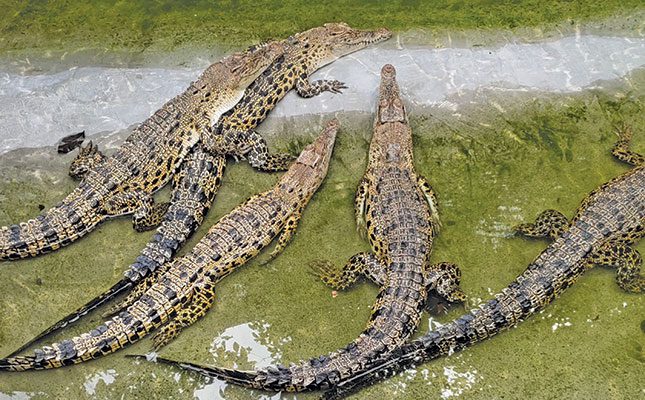
Photo: Wikimedia Commons
As Africa emerges from a season of pandemics and climate extremes, and braces for yet another drought, there is an urgent need to find new, sustainable ways to feed the continent’s growing population.
In Asia, reptiles are playing a small but increasingly important role in addressing a wide range of novel agri-food challenges. Could reptile farming help Africa in a similar way?
But why reptiles?
As a highly specialised group of animals, reptiles require 90% less food calorie inputs and can cope with extreme conditions better than most warm-blooded animals, and they do not transmit dangerous diseases.
The impacts of climate change are bearing down on Africa’s livestock systems like never before. A high likelihood of El Niño arriving on the back of record-breaking temperatures could severely strain both livestock production and fisheries.
The long-term climate forecast suggests this situation will continue to deteriorate. Efforts to feed our growing population with safe, nutritious, and sustainable food are failing. Globally, over two billion people are food insecure, almost 700 million are undernourished, and 30% of children in Africa lack the nutrition required to stave off childhood stunting.
One of the key challenges we face is that our food systems are dominated by energetically extravagant and inefficient livestock.
As much as 80% of the food calories birds and mammals consume are used for nothing more than maintaining an elevated temperature for their basal metabolic rate. Three quarters of Earth’s farmed protein draws on just five species, all of which have similar warm-blooded physiologies to our own.
Downside of livestock
Simply put, farming our current energy-intensive and disease-prone livestock on our energy-deficient and unpredictable planet is no longer feasible. Furthermore, most of the carbohydrates we produce rely on calorie-rich but nutrient-poor monocultures, contributing to a narrowing of diets, diminishing democratic food sovereignty, and epidemics of malnutrition linked to ultra-processed foods.
We simple can’t produce enough nutrient-dense food to go around. Trying to solve the global food security crisis in the absence of diverse livestock systems is bad for the environment, and bad for our health.
As it stands, extreme weather events will have increasingly catastrophic impacts on our food systems over the coming decades. A report released by the Intergovernmental Panel on Climate Change has confirmed that a 1,5°C rise in global temperature is now unavoidable, with 2,5°C likely by the end of the century.
Following the unprecedented number of record-breaking weather events that have occurred since the beginning of the year, many scientists now argue that previous climate models have been too conservative.
Heatwaves, droughts, and disease are here to stay. So too are the more subtle knock-on effects – the quiet demise of thousands of vulnerable farmers who depend on stable and predictable weather patterns for their livelihoods.
And it is not just people who will suffer: more than a third of global anthropogenic greenhouse-gas emissions and about 70% of all freshwater usage go to food production. Agriculture is the leading cause of habitat degradation and a principal driver behind the biodiversity crisis.
Most of what we have now is either unsustainable or unscalable, and nothing short of radical transformation is required.
Whatever food system comes next must produce greater quantities of a more diverse range of nutrient-dense foods.
It must also produce these foods sustainably, reversing current trajectories of land degradation so that production acts as a reservoir for biodiversity and is a driver of ecological integrity.
Cultural bias
Reptiles are often overlooked in mainstream food systems because of our fundamental cultural and religious biases. In Africa, for example, pythons were once widely consumed throughout the continent, but they were listed as ‘royal game’ by wildlife authorities in the 1960s. Harvest, trade and consumption have remained illegal ever since.
Few people outside of the tropics realise that reptiles are consumed by over a billion people. Historically, they made up an important part of the human diet, just like chicken or fish, and still do in many societies.
It is only because they were intentionally excluded from the industrialisation of agriculture in the last century, and the subsequent globalisation of Western culture, that we do not see more reptile meat on our supermarket shelves.
Now, rising costs and environmental threats are forcing a seismic shift in food systems, and some farmers are making a concerted shift towards reptiles.
More than 40 different species of snakes, lizards, turtles and crocodiles are now farmed for meat, skins and pharmaceuticals.
Reptiles are fundamentally more resource efficient compared with warm-blooded livestock.
They are extremophiles, which means they live in difficult conditions. They are energy specialists, a sort-of biological hybrid between solar-powered chickens and dryland aquaculture.
Many species are adapted to famine and extreme heat. Burmese pythons, for example, a commonly farmed species in Asia, have a unique and highly specialised physiology that allows them to fast for months on end without food or water, and without jeopardising survival or reproductive fitness.
In the farming context, they offer a means of livestock ‘banking’, a unique adaptive metabolic physiology that embraces disruptions in supply chains and negates periods of environmental or market volatility.
The ability of many reptiles to live both above and below ground provides opportunities for farmers to buffer against heatwaves. Indeed, many production systems are orientated on the vertical rather than horizontal plane, and incorporate underground structural components to help buffer against the impacts of extreme heat. Vertical farming also allows for space savings, making reptile farming a popular choice for smallholders.
Because they are cold-blooded, with a very different physiology to our own, reptiles offer a natural biological barrier to transmissible viral diseases such as COVID-19, bird flu, and swine flu.
Diversification of our livestock systems away from warm-blooded species not only saves on resource inputs, but it can also help diminish the risk of zoonotic disease outbreaks.
One drawback of reptile farming is that most farmed species are obligate carnivores, and therefore require a high-protein diet, but this too may be a positive.
Resource efficiency promotes digestive efficiency, and many reptile species have the ability to digest and assimilate almost anything they eat, even dense connective tissue like bone. As a result, reptile farms produce minimal waste.
The by-products of protein synthesis are water-insoluble urates rather than volatile urea, and therefore reptile farms produce less water and air pollution compared with warm-blooded livestock. This is another reason they are so popular with peri-urban smallholders.
A combination of hyper-efficient digestive physiologies and energy-efficient behaviours means reptile production outputs require similar protein inputs to poultry, but they do not need the energy-rich carbohydrate component that is so important for all warm-blooded physiologies.
Many farms are also located in close proximity to cheap and abundant sources of waste protein.
In Vietnam, for example, wild-harvested rodents and by-products from pork, poultry and fish production facilities make up the bulk of food inputs.
In such cases, reptiles act as a means of upcycling unwanted waste and controlling important crop pests.
Business model
But does the business model stack up? Many species of reptiles are relatively cheap and easy to farm, provided there is access to the right knowledge and technology.
These are two prerequisites that have been fundamentally limiting until fairly recently, because the science of reptile production is very different to traditional agriculture and has lacked investment from big agribusiness.
However, the widespread availability and affordability of climate control technology and online information has changed all this, and even small-scale farmers have access to smartphones and cheap greenhouses.
Reptile meat is nutritious and versatile, not unlike chicken, and it is considered a culinary delicacy by many of the world’s leading cuisines.
As a mainstay of many authentic Cantonese dishes, it has ready-made market appeal for hundreds of thousands of Chinese restaurants worldwide, and as a future-ready meat with intrinsic cookery appeal, it stands a good chance of becoming a household staple.
Cows, pigs, sheep and chickens have all suffered the effects of decades of selective breeding and veterinary interventions. Maximum outputs driven by the unlimited resource inputs of a ‘Goldilocks climate’ have been overriding production imperatives.
Modern meat chickens are now so modified they present a fundamental welfare concern in all but the most optimal growing conditions. These hyper-specialised variants often perform poorly under the rigours of unpredictable environmental stresses.
For the farmer, transformational change of traditional livestock breeds at this late stage in the game represents a difficult and risky endeavour.
The last time reptiles ruled the world was 65 million years ago; at that time carbon dioxide levels were six times what they are today, and global temperatures were 4°C warmer. Since the downfall of the dinosaurs, the extravagant economies of warm-blooded animals have dominated planet Earth.
Now the winds of change are blowing again and Anthropocene storm clouds are on the horizon.
We need radical transformation towards agricultural resilience. Reptiles are the original hothouse specialists, and they might just be the sustainable livestock we are looking for.
Email Dr Patrick Aust at [email protected].











